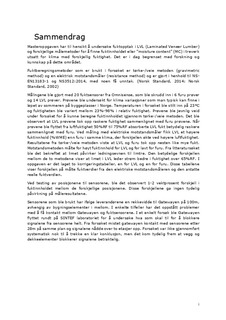Fuktmåling i LVL med trådløse sensorer
Master thesis
Permanent lenke
http://hdl.handle.net/11250/2621261Utgivelsesdato
2019Metadata
Vis full innførselSamlinger
Sammendrag
Masteroppgaven har til hensikt å undersøke fuktopptak i LVL (Laminated Veneer Lumber)og forskjellige målemetoder for å finne fuktinnholdet eller ”moisture content” (MC) i treverkutsatt for klima med forskjellig fuktighet. Det er i dag begrenset med forskning ogkunnskap på dette området.
Fuktberegningsmetoder som er brukt i forsøket er tørke-/veie metoden (gravimetricmethod) og en elektrisk motstandsmåler (resistance method) og er gjort i henhold til NSEN13183-1 og NS3512:2014, med noen få unntak. (Norsk Standard, 2014; NorskStandard, 2002)
Målingene ble gjort med 20 fuktsensorer fra Omnisense, som ble skrudd inn i 6 furu prøverog 14 LVL prøver. Prøvene ble undersøkt for klima variasjoner som man typisk kan finne iløpet av sommeren på byggeplasser i Norge. Temperaturen i forsøket ble stilt inn på 23°Cog fuktigheten ble variert mellom 23%-98% i relativ fuktighet. Prøvene ble jevnlig veidunder forsøket for å kunne beregne fuktinnholdet igjennom tørke-/veie metoden. Det bleobservert at LVL prøvene tok opp raskere fuktighet sammenlignet med furu prøvene. Nårprøvene ble flyttet fra luftfuktighet 50%RF til 75%RF absorberte LVL fukt betydelig raskeresammenlignet med furu. Ved måling med elektriske motstandsmåler fikk LVL et høyerefuktinnhold (%WME) enn furu i samme klima, der forskjellen økte ved høyere luftfuktighet.Resultatene fra tørke-/veie metoden viste at LVL og furu tok opp nesten like mye fukt.Motstandsmetoden målte for høyt fuktinnhold for LVL og for lavt for furu. Fra litteratursøketble det bekreftet at limet påvirker ledningsevnen til limtre. Den betydelige forskjellenmellom de to metodene viser at limet i LVL leder strøm bedre i fuktighet over 65%RF. Ioppgaven er det laget to korrigeringstabeller, en for LVL og en for furu. Disse tabelleneviser forskjellen på målte fuktverdier fra den elektriske motstandsmåleren og den antattereelle fuktverdien.
Ved testing av posisjonene til sensorene, ble det observert 1-2 vektprosent forskjell ifuktinnholdet mellom de forskjellige posisjonene. Disse forskjellene ga ingen tydeligpåvirkning på måleresultatene.
Sensorene som ble brukt har ifølge leverandørene en rekkevidde til Gatewayen på 100m,avhengig av bygningselementer i mellom. I enkelte tilfeller har det oppstått problemermed å få kontakt mellom Gatewayen og fuktsensorene. I et enkelt forsøk ble Gatewayenflyttet rundt på SINTEF laboratoriet for å undersøke hva som skal til for å blokkeresignalene fra sensorene helt. Fra forsøket mistet gatewayen kontakt med sensorene etter28m på samme plan og signalene nådde over to etasjer opp. Forsøket var ikke gjennomførtsystematisk nok til å trekke en klar konklusjon, men det kom tydelig frem at vegg ogdekkeelementer blokkerer signalene betraktelig. This master's thesis aimed to investigate moisture absorption and desorption in LVL(Laminated Veneer Lumber) exposed to atmospheric environments of different humidityand whether different measurement methods would give deviation in measured moisturecontent. Two different measuring methods were used to find the moisture content (MC).Research and knowledge in this area are currently limited.
The methods used to measure MC in this experiment are the gravimetric method and theelectrical resistance method. The measurements are done according to methoddescriptions in NS-EN13183-1 and NS3512: 2014, with a few exceptions. (NorwegianStandard, 2014; Norwegian Standard, 2002)
The measurements were conducted with 20 moisture sensors from Omnisense screwedinto 6 pine pieces and 14 LVL pieces. The samples were examined in atmosphericconditions typical for a construction sites during a Norwegian summer, with temperaturesaround 23°C and humidity variation of 23% to 98% RH. The weight of the samples waschecked regularly during the experiment in order to calculate the moisture contentaccording to the gravimetric method. The electrical measurement results showed that theLVL pieces absorbed moisture faster than pine pieces. When moved from an environmentof 50% to 75% RH, LVL absorbed moisture considerably faster than pine according to theelectrical measurements.
In summary when measuring with electric resistance meters, LVL had a higher moisturecontent (% WME) than pine in the same climate, and the difference increased with higherhumidity. The results from the gravimetric method showed that LVL and pine actually hadthe same moisture content. The indicated moisture content from the resistance methodwas too high for LVL and too low for pine. Results from the literature review highlights thatthe glue in glued laminates affects the materials electrical conductivity. Why themeasurements for pine was too low has not been assessed. The significant differencebetween the two methods shows that the adhesive in LVL conducts the electrical currentbetter in moist environments above 65% RH. In this thesis, there are two correction tables,one for LVL and one for pine. These tables show the difference in measured moisturecontent from the electrical resistance meter from Omnisense and the actual moisturecontent.
When testing the positions of the sensors, results showed that such changes can have aneffect of 1-2% in moisture content. However, this did not result in distinct impact on theresults.
The sensors have, according to the vendor, a signal range of 100m to the gateway,depending on the building elements in between. In some cases, the contact between thegateway and the humidity sensors has been problematic. In an attempt to investigate thisproblem further, the gateway was moved around the SINTEF laboratory to determine whatwas needed to completely block the signals from the sensors. The results from thisinvestigation showed that the gateway lost contact with the sensors already at a distanceof 28m on the same floor and the signals reached over two floors. A clear distinct conclusioncannot be drawn, since the investigation was not carried out in a systematic manner.
